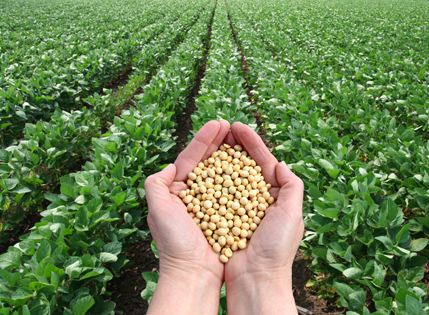Market Commentary from Kottke Commodities – Commodity Capital CTA – Kenneth Stein
 The amplitude of grains and oilseed prices last month was extraordinarily narrow. Soybeans were the most-contained, with a high-to-low closing price range of just 28c in the March contract, narrowest for January since 1998. It’s even more remarkable considering that on the 12th, USDA surprised the trade by reducing the 2015-16 U.S. crop by 50 million bushels. The reason that such stable matching of supply and demand rarely persists for a month is the constant fresh assessments of risks to production of crops in the field and the next to be planted. Today, such is the adequacy of supply and geographic diversification of growing areas that the market judges risk to be lowest in decades. The amplitude of grains and oilseed prices last month was extraordinarily narrow. Soybeans were the most-contained, with a high-to-low closing price range of just 28c in the March contract, narrowest for January since 1998. It’s even more remarkable considering that on the 12th, USDA surprised the trade by reducing the 2015-16 U.S. crop by 50 million bushels. The reason that such stable matching of supply and demand rarely persists for a month is the constant fresh assessments of risks to production of crops in the field and the next to be planted. Today, such is the adequacy of supply and geographic diversification of growing areas that the market judges risk to be lowest in decades.
It’s always folly to bet on one’s opinion of prices for years to come, begging the question: Might the current prospects for comfortable-to-excess world supply really persist? The new nation-entrants into the agricultural-export trade, accompanied by much new investment in farmland and supporting infrastructure, suggests that it can. It’s not just fortunate weather that has swelled food supplies, but new productive capacity. In addition, the hangovers from various government farm-subsidy schemes will now act as price suppressants for a few years: China’s central planners have maintained a very high guaranteed price for corn to encourage rapid modernization of archaic farm techniques. Lots of free money produced the predictable result of a huge, expensive and low-quality government stockpile, and sunk-cost investments based on unrealistically high returns. This corn will be sold into domestic channels, sharply reducing feedgrain imports for the next few years. Every major edible-oil exporter mandates a sizable volume for domestic conversion into a diesel-fuel substitute, in the belief it mitigates environmental degradation (but more likely, to curry favor with landowners, everywhere a powerful constituency.) The list is lengthy: Brazil, Argentina, U.S., E.U., Indonesia, Malaysia. The collapse of petroleum prices has rendered all of these mandates wildly uneconomic, where before they were merely wasteful, simultaneously increasing the retail price of fuel and food and reducing export revenue. One would expect most of these laws, counterproductive except for agricultural producers, to expire unfulfilled. Sen. Cruz won the Iowa Republican Presidential primary on a platform stressing reduction in government crony capitalism, including ethanol mandates of which the state is the primary beneficiary – despite the heated anti-Cruz rhetoric of Iowa’s Governor, whose son heads a pro-ethanol agitation group. This has been interpreted as a sign of the times, a sea-change of public attitude, with the federal muscle behind ethanol now perhaps in question for the long term. As some 40% of the U.S. corn crop is involved, the impact of any policy change would be enormous for the world grain market. Experience teaches that it’s unwise to hold one’s breath for Congress to sunset a law even even when original proponents concede that it was a mistake. But the surprising flat trend of gasoline consumption despite crashing prices may limit the ethanol industry even if Washington doesn’t deal with the problem. World grain and oilseed production has expanded greatly over the last few years in all hemispheres, and along with it demand for fertilizer, chemicals, and fuel. But their supplies have also now expanded, and their prices fallen. So every link in the supply chain of adequate world grain supply appears well-stocked. The financial situations of Brazil, Argentina, Russia and Ukraine remain on the precipice, and natural disasters are to be expected. But it would seem that an extended period of low food prices is ahead. Still, supply is only one side of the ledger: World demand growth for all grains remains above average, unlike other raw materials. It’s instructive to consider the situation in China, for the last decade the volume leader in trade growth of nearly all basic commodities, but now cutting back. While it remains Communist, its citizens can travel and move money elsewhere, and despite censorship are reasonably well-connected to foreign media. This clarifies the social contract between repressive regime and commoner as one of rising living standards. So even as new construction slackens, dietary improvement is unlikely to. For the U.S., its choice to mandate ethanol in vast volume has relegated it to a reduced export role, from forefront to residual supplier to the world’s grain and oilseed customers. It may still be the most flexible and reliable shipper but that advantage too is waning rapidly due to port and infrastructure investment elsewhere. Yet this does not mean that the CME agricultural futures will lack for opportunity. That 18-year low in January soybean-price fluctuation represents 3% of total price. Roughly double that normally occurs every month in this business, offering far more trading opportunity than the stocks and bonds with which it is poorly correlated. The entire supply of grains and oilseeds must be refreshed from scratch each year, unlike mines or wells whose output reliably extends for decades. And the world’s food consumption continues to absorb larger, lower-priced supplies at a rate of growth that will outstrip that of any other sector in 2016. |
|
|
